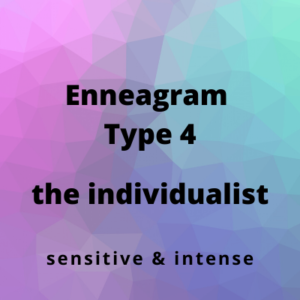Enneagram Type 4: The Individualist
Did you get an Enneagram Type 4 result on a personality test? Keep on reading to learn more about what it means!
Want to know how people handle their emotions and conceptualize the world? Then you may want to consider trying the Enneagram personality test.
This model consists of nine different personality types that are mapped on a nine-point diagram to see how they relate to each other. Enneagram is derived from the Greek words Ennea which mean nine and Gramma which means something drawn or written.
Since the method believes each type has its own way of seeing the world, it lets you understand why some people behave a certain way. By knowing how they may react to specific events, the model can be used as a form of self-improvement as well.
Enneagram Type Four: Defining traits
Of the nine possible Enneagram results, ‘The Individualist’ is the best way to describe the fourth type. Its main characteristics are:
- Sensitive and intense
- Has a unique inner and outer appearance
- Is artistic
- Lovable and quirky
- Has a strong sense of self-worth
- Expressive
- Often feels a sense of emptiness
- Usually in a melancholic mood
What are they like?
Individualists stand out from the crowd for their unique fashion statements and unusual hobbies. They’re usually the oddballs who have a relentless drive to know who they really are inside.
Creation, not consumption, is the focus of their individuality.
They spend a lot of time reminiscing and use those emotions as inspirations for new projects. Since they continuously discover their inner selves, Individualists produce original works without seeking the approval of others.
Their core values
Self-expression and authenticity define an Individualist. They also want to be remembered and appreciated for their unique identity.
Furthermore, they feel like they should be consistent in maintaining their distinctiveness from others. Giving in to ‘trends’ is seen as the ultimate act of self-betrayal.
How to recognize an enneagram type 4
Offbeat, Individualists take pride in being unique. They have a strong sense of self-expression, too, and are most likely drawn to creative outlets such as theatre, arts, or music.
They feel the most complete when they’re able to express themselves accurately. They tend to be more open-minded as well and are very open to discovering their inner selves.
Flea markets and thrift shops are a favourite of Individualists. They take self-expression seriously and are constantly wondering if their decisions are aligned with their philosophy.
Enneagram Type 4: What they’re like at different levels
Normal Level
Individualists create unusual pieces of art that change perspectives for the better. They’re called idea synthesizers and can help others rethink how art should be.
Major shifts in fashion and art are usually started by Individualists since they get inspiration from past experiences. They also often think out-of-the-box.
They’re highly attuned with the complexity of their emotions. So, Individualists undergo stages of metamorphosis where they start as a cocoon (level of self-acceptance) before turning into a butterfly to express who they really are.
Moderate Level
Individualists use various creative outlets to de-stress. They gravitate toward people who think the same way to gain support and inspiration.
They seek authenticity and maybe introspective—to the point of testing other’s patience or hurting their feelings. Individualists are self-absorbed and follow their own guidelines to discover their true selves.
Also, they can be super sensitive to criticisms yet unreflective towards themselves. This means they always look for flattery and can be offended when someone relates to or copies their experiences.
Extreme Level
Individualists can become extremely depressed or moody. They tend to feel too deeply, which they don’t realise can be hurting their natural creativity.
Worse, they may become unrealistic and use hallucinogens or alcohol as coping mechanisms.
Their search for the ‘missing piece’ leads them to an unending spiral of dead ends. They refuse to admit self-destructive behaviours, too, which causes them to constantly make the same mistakes.
Lastly, Individualists are prone to thinking something’s wrong with them. When they’re extremely stressed, they isolate themselves from their loved ones instead of asking for help.
